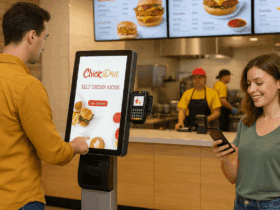The restaurant industry is constantly evolving, driven by changing consumer preferences, technological advancements, and global events. As we get ready to welcome 2024, it’s essential for restaurant owners and operators to stay ahead of the curve and adapt to emerging trends.
In the restaurant industry, it’s crucial to stay updated with the latest trends. This article will dive into the top 10 trends in the restaurant industry that are set to redefine the dining experience in the upcoming year

1. Tech-driven dining experiences in the restaurant industry:
Dining in the digital age goes beyond online reservations. Augmented reality (AR) is making inroads into the menu, offering 3D visualizations of dishes, ensuring that patrons know exactly what to expect. Artificial intelligence (AI) could soon become your next food critic, suggesting dishes based on past preferences, current mood, or dietary needs. Interactive tables that let customers play games, read news, or explore the origins of their food might also gain prominence.
2. The rise of special eateries in the restaurant industry:
In an age of personalization, one-size-fits-all is passé. Special eateries catering to vegan, gluten-free, paleolithic, and numerous other diets will proliferate. These will go beyond dietary restrictions, opening the door to gourmet adventures. Think vegan sushi bars, keto gourmet bistros, and more, that push the boundaries of culinary artistry within dietary frameworks.
Must Read : Improve Restaurant Dining Experience and Revenue using Self-ordering Kiosks
3. Sustainability takes center stage in the restaurant industry:
The eco-conscious diner wants more than organic salads. They seek restaurants that embed sustainability in their DNA. Renewable energy, zero-waste kitchens, upcycled furniture, and even rainwater harvesting could become normative. The farm-to-table trend may evolve into a more interactive experience with diners getting insights into the journey of their food through AR or virtual reality (VR).
4. Quick service reinvention for the restaurant industry:
Gone are the days when quick service meant greasy fries and burgers. Modern quick-service restaurants are elevating the customer experience. From offering gourmet sandwiches and salads prepared in record time to integrating technology for seamless order and pickup, the line between quick service and fine dining is blurring.
5. Home dining 2.0:
With the rise of home chefs and culinary enthusiasts, restaurants are tapping into the DIY gourmet trend. Customizable meal kits, with ingredients sourced directly from restaurant suppliers and detailed chef-guided recipes, will cater to those who want the restaurant experience in their own kitchen. Live virtual cooking classes with renowned chefs might also become a favorite weekend activity.
6. Experiential dining trends in the restaurant industry:
A meal is no longer just about the food; it’s about the entire experience. Eateries are blending dining with entertainment. Expect more establishments where culinary arts meet performing arts – jazz nights, poetry readings, or even immersive theater where the story unfolds as you dine.
7. Health and wellness at the forefront:
A healthy body and mind are modern-day treasures. Restaurants are catering to this by infusing wellness into dining. Menus enriched with superfoods, dishes calibrated for specific health benefits, and options like post-meal meditation or yoga sessions could become commonplace. Some might even partner with health experts to offer nutrition counseling or wellness workshops.
8. Localization over globalization:
While global flavors have their allure, there’s a renewed interest in local tales and tastes. Customers are keen on rediscovering forgotten regional dishes, heirloom ingredients, and traditional cooking techniques. Storytelling will play a pivotal role, with chefs narrating tales of the dishes, the history behind them, and their personal experiences intertwined with these culinary delights.
9. Data-driven personalization:
In an era of big data, personalization is the key. Sophisticated analytics tools will analyze customers preferences, allergies, favorite flavors, and even moods to craft bespoke dining experiences. This could range from suggesting dishes to tailoring the entire ambiance to the diner’s preference, ensuring a truly unique dining adventure.
10. Financial flexibility:
Economic uncertainties and the quest for value will push restaurants to reimagine their pricing strategies. Subscription-based dining, where customers pay a monthly fee for a set number of meals, might gain traction. Dynamic pricing models, loyalty points redeemable across a chain of eateries, and even cryptocurrency-based payments could redefine the financial landscape of dining.
As 2024 approaches, the restaurant industry is set for transformative change, driven by technology and evolving consumer needs. The lines between dining categories blur, with technology like augmented reality redefining experiences, and a renewed focus on localized, sustainable offerings. Personalization is key, powered by data analytics, while innovative financial models cater to changing economic realities. For restaurateurs, staying adaptable and in-tune with these trends is paramount, as the future of dining melds technology, culinary artistry, and holistic well-being.










Leave a Reply